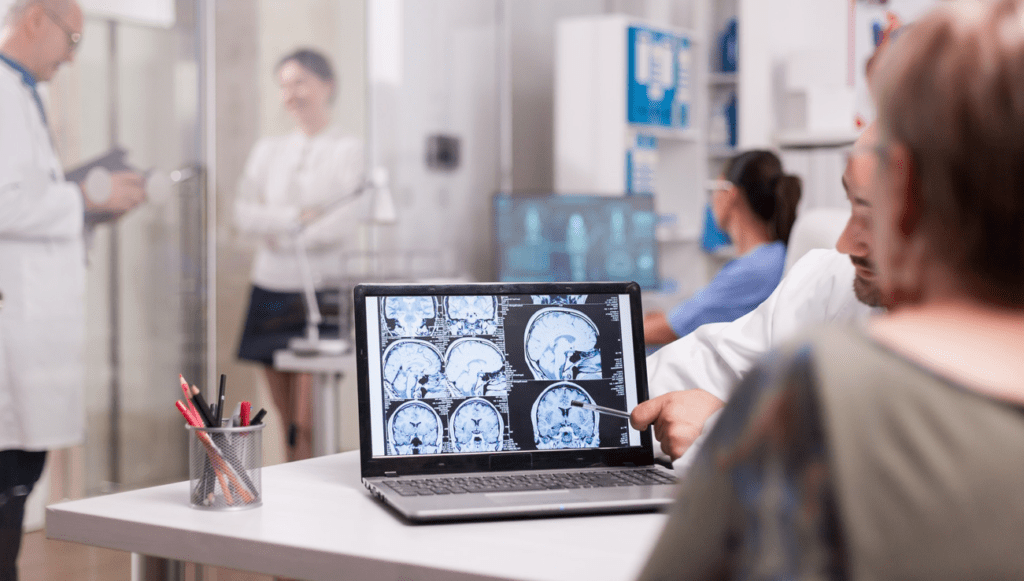One of the most complicated and debilitating illnesses affecting human health is neurodegenerative disease. Pick’s disease, a type of frontotemporal dementia (FTD), is much less well understood than Alzheimer’s, which commands the majority of public discourse. This uncommon but violent brain illness impairs personality, behavior, and thought processes and frequently manifests far earlier than other forms of dementia.
Pick’s disease has already started its irreversible course by the time the majority of people become aware of its symptoms. Pick’s disease affects the frontal and temporal lobes, causing significant personality changes, emotional instability, and a loss of social awareness, in contrast to Alzheimer’s disease, which primarily affects memory. However, what causes this condition specifically, and is there a chance that it can be treated?

Understanding Pick’s Disease: A Degenerative Brain Disorder
The prevalence of Pick’s disease, a form of frontotemporal dementia (FTD), is estimated to be between 15 and 22 per 100,000. Pick’s disease is a major cause of early-onset dementia because it frequently affects people as young as 40 and as old as 80, in contrast to Alzheimer’s, which usually manifests in later life.
Dr. Arnold Pick, who made the initial identification of the disease in 1892, is honored by the disease’s name. The presence of aberrant protein deposits known as “Pick bodies” inside brain cells is what defines it. These deposits cause cell death and shrinkage of the brain tissue by interfering with normal neuron function. This eventually results in significant behavioral alterations, trouble speaking, and a decline in executive function.
Key Facts About Pick’s Disease
| Category | Details |
|---|---|
| Medical Name | Pick’s Disease (a form of FTD) |
| Primary Affected Areas | Frontal and Temporal Lobes |
| Key Symptoms | Personality changes, impaired judgment, lack of emotional control, difficulty speaking |
| First Identified By | Dr. Arnold Pick in 1892 |
| Average Age of Onset | 40-65 years |
| Life Expectancy | 5-10 years after diagnosis |
| Genetic Risk Factors | Linked to certain gene mutations, though most cases are sporadic |
| Current Treatments | No cure; symptom management through behavioral therapy and medications |
| Diagnosis Methods | Brain scans, neurological exams, genetic testing (definitive diagnosis only via autopsy) |
| Estimated Prevalence | 15-22 cases per 100,000 people |
For more information, visit Alzheimer’s Association
Symptoms: When Personality and Behavior Begin to Change
Early symptoms of Pick’s disease are frequently ignored or mistakenly ascribed to aging, stress, or mental health issues. But as the illness worsens, the symptoms become more bothersome and transformative.
Common Symptoms Include:
- Personality Shifts: Sudden rudeness, social inappropriateness, or loss of empathy.
- Speech Difficulties: Trouble finding words, forming sentences, or understanding speech.
- Emotional Detachment: Lack of response to emotional situations, indifference to loved ones.
- Compulsive Behaviors: Repetitive hand movements, hoarding, or excessive eating.
- Poor Judgment: Impulsivity, inappropriate financial decisions, or reckless behavior.
- Apathy: Loss of motivation, reduced social interaction, and neglect of personal hygiene.
The fact that many Pick’s disease patients are ignorant of their illness is one of its most cruel features. In contrast to Alzheimer’s disease, which is characterized by a significant loss of memory, Pick’s patients may still have memories but lose all social and emotional awareness.
What Causes Pick’s Disease? A Look at the Science
The aberrant buildup of tau proteins, which result in clumps called Pick bodies, is the primary cause of Pick’s disease. These cause progressive brain shrinkage and brain cell death by interfering with neuron function.
Potential Causes & Risk Factors:
- Genetic Mutations – While most cases are sporadic, some gene mutations have been linked to the disease.
- Protein Malfunctions – Abnormal tau protein buildup causes neuron degeneration.
- Family History – Having a close relative with FTD slightly increases risk.
- Unknown Environmental Factors – No conclusive evidence links Pick’s disease to environmental toxins.
Amyloid plaques are not a factor in Pick’s disease, in contrast to Alzheimer’s. Rather than memory loss, it mainly impacts speech, behavior, and executive function.
How Is Pick’s Disease Diagnosed?
Pick’s disease is difficult to diagnose because its early symptoms can be mistaken for those of schizophrenia, bipolar disorder, or depression. Doctors rely on neurological evaluations, MRI scans, and genetic testing because there isn’t a single test that can confirm it.
Common Diagnostic Methods:
- Neurological Evaluation: Doctors assess behavior, speech patterns, and cognitive function.
- Brain Imaging (MRI, PET Scans): Detects brain shrinkage and frontal/temporal lobe atrophy.
- Genetic Testing: Identifies inherited mutations linked to FTD.
- Neuropsychological Tests: Measures executive function and emotional responses.
Only autopsy and microscopic analysis of Pick bodies can provide a definitive diagnosis after death.
Is There a Cure? Current Treatments and Future Hope
Pick’s disease currently has no known cure, and the only treatments available target symptom management. But there is hope for the future thanks to new findings in neuroprotective medications, stem cell therapies, and gene therapy.
Current Treatment Options:
- Behavioral Therapy: Helps manage impulsive behaviors and improve daily functioning.
- Antidepressants & Mood Stabilizers: Reduce aggression and agitation.
- Speech Therapy: Assists patients in maintaining communication skills.
- Occupational Therapy: Supports daily task management.
Future discoveries may result from the active research of possible therapies that target the buildup of tau proteins.
What’s Next? The Future of Pick’s Disease Research
In neurodegenerative research, the medical community is making tremendous progress, and Pick’s disease is at last getting the attention it merits.
- Tau Protein Research: Scientists are working on drugs that prevent tau protein clumping, which could slow or halt disease progression.
- Stem Cell Therapy: Early trials are exploring the use of stem cells to regenerate lost neurons.
- AI-Assisted Diagnosis: Machine learning is being used to detect Pick’s disease earlier based on subtle changes in speech patterns.
Although there is currently no cure, developments in neuroprotection and genetic medicine may alter how Pick’s disease is treated in the upcoming ten years.
